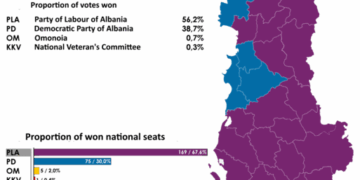
While the mainstream media is making much out of the issue of wages in the strike called by the International Longshoremen’s Association (ILA) on Tuesday, the real issue is one that goes back more than a century: automation.
Said ILA’s Executive Vice President Dennis Daggett: “Automation, which I believe we are going to be battling for the rest of our existence, is a high-priority issue.”
Daggett added, “We see the automation that they [the United States Maritime Alliance, or USMX, which represents major freight and port operators] are implementing in certain ports and we’re not going to allow that cancer to come here on the East Coast.”
Daggett may be referring to a slight change in operations at the port in Mobile, Alabama. The port is using an automated gate system that processes trucks entering and leaving the terminal without the use of ILA labor. He claims that tiny improvement violates the existing labor contract with the USMX.
That’s an issue that USMX isn’t willing budge on. The present contract already constrains port operators from installing improvements that would move goods much more quickly, safely, and more efficiently. Those improvements would also likely displace a few of the estimated 25,000 workers currently out on strike.
The Issue Remains the Same
Automation is an issue that has divided management and labor for nearly two centuries. Striking ILA workers hold signs that read “Machines Don’t Feed Families. Support ILA Workers.” The Luddites were textile workers in Nottingham, England, who violently protested the introduction of automated machinery in the early 19th century. If the ILA Luddites have their way, the U.S. would look like 19th century England.
That might be an exaggeration, but consider what economists are predicting if the strike lasts longer than a few weeks: The work stoppage, including the vast ripple effects of shutting down half of America’s imports, could cost the economy more than $4 billion every day. And shifting supply lines to southern and western ports would slow traffic, raise costs, and delay the delivery of critical parts needed to keep the economy running.
The advantages of automation are well known. Ever since Henry Ford installed the assembly line more than a hundred years ago, raising the average wage to $5 a day and allowing the average American worker to afford the very cars they were building because of lowered costs, automation has allowed living standards to increase dramatically. Those advantages include labor savings, reduced wastage, savings in energy and material costs, and vast improvements in quality. These flow through to the ultimate end user in products that are more useful and cost less.
Poor Performance
Daggett and his Luddites at the ILA are standing astride progress. Estimates are that half of all current jobs have the potential to be fully automated in less than 10 years. But because of present restrictions in the labor contract between the ILA and the USMX, those ports being struck by workers rank near the bottom of global port efficiency ratings.
According to the World Bank’s 2022 Port Performance Index, the average North American port ranking is lower than East Asian ports, are half as efficient as Central American, South American, and Caribbean ports, and are barely ahead of sub-Saharan African ports.
As Rachel Greszler, an economist with the Economic Policy Innovation Center, noted:
[W]hen ports move containers more quickly, they can move more total containers, generating higher revenues that support rising wages and new jobs. And, when goods move more quickly through the supply chain, that translates into lower costs for consumers.
The strike could end if Joe Biden wanted to invoke the 80-day cooling off period allowed by the Taft-Hartley Act. But no: For political reasons he won’t invoke that power. That would be “anti-union,” and his Vice President, Kamala Harris, desperately needs every union vote she can muster to head off the Trump steamroller heading for November.
Related article:

































